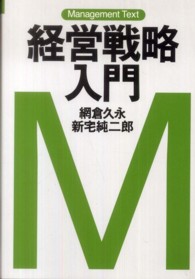基本説明
This book investigates cross-linguistic variation in one of the core domains of all natural languages. Leon Stassen views this domain as a 'cognitive space', the topography of which is the same for all languages.
Full Description
This book investigates cross-linguistic variation in one of the core domains of all natural languages. Leon Stassen views this domain as a 'cognitive space', the topography of which is the same for all languages. It is assumed to consist of four subdomains, which correspond to a four-way distinction between the semantic classes of event predicates, property predicates, class predicates, and locational predicates. The book offers a typology of the structural manifestations of this domain, in terms of the nature and number of the formal strategies used in its encoding. The author disusses a number of abstract principles which can be employed in explaining the cross-linguistic variation emodied by the typology. In the final chapter he brings together the research results in a universally applicable model, which can be read as a 'flow-chart' for the encoding of intransitive predications in different language types.
Contents
PART 1: THE TYPOLOGY ; 1. Introduction ; 2. The Verbal and the Locational Strategy ; 3. The Nominal Strategy ; 4. The Typology of Intransitive Predication ; PART 2: SWITCHING ; 5. Adjective-Switching ; 6. Nominal and Locational Switching ; 7. Verb-Switching ; 8. Multiple Switching and Complex Cases ; PART 3: TENSEDNESS ; 9. Adjectives and the Tensedness Parameter ; 10. Tensed Languages ; 11. Non-Tensed Languages ; 12. Problematic Cases ; 13. Evaluation and Explanation ; PART 4: THE MODEL ; 14. The Model of Intransitive Predicate Encoding ; 15. Conclusion ; Notes ; Appendices ; References ; Indices







